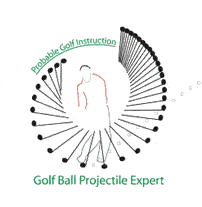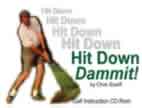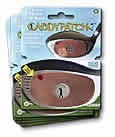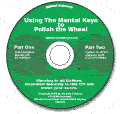
![]() Click here to see
Click here to see
Ken Tannar, PGI Creator
Golf Contents
·Privacy
Policy
·Secure Server
·Home
Instruction-Tips
Putting
·Putting
Handicap Analysis
·Reading
Greens
·Downhill/Uphill
·Stimpmeter
·Putting
Alignment
·BreakMaster
Reader New
·Sun's
UV Index New
Club
Selection
·Golf
Club Distances
·Uphill/Downhill
Shots
·Adjusting
for Wind
Mental
Golf
·Golf
Solutions Book
Personally
Engraved Ball Markers!
Pro Shop
·Great
Golf Gifts
·Golf
Tips-Product Order
·Reading
Putts
·Wind
Effects
·Shot
Patterns
·Elevation
Changes
·Fair
Handicap Analysis ·Tournament
Draws/Groupings
·Order
Golf Bag of Tips
·Teego
Golf Ball Dispenser
·BreakMaster
Reader New
Equipment
Golf
Ball
·Longest
Golf Ball Study
·Distance
Calculator
·Distance,
Spin & Feel New
Golf
Club
·Distance
Technology
·History
of Clubs & Balls
·Online
Golf Equipment
·Golf
Club Distances New
Golf
Swing
·Hit
Down Dammit! CD
·Swing
Machine Book
·Dream
Swing
Golf Science
Science
of Golf
·Golf
Ball Trajectory
·Club
Range Compare
·Golf
Ball Review
·Golf
Science Resources
Weather
Effects
·Temperature
·Humidity
·Wind
·Air
Pressure
Statistics
·Fair
Handicap Analysis
·Handicap
Calculator New
·Shot
Pattern Probablilities
·Free
Report
·Master
Your Game
·Longest
Golf Ball Study
·Hole
Difficulty Calculator
·Tournament
Draws/Groupings
·Putting
Handicap Analysis
Books
Newsletter
Free
Golf Newsletter
·Current
·Archives
Ask the Expert
·Golf
Questions
·Consultation/Litigation
of Errant Golf Balls
·Golf
Course Measuring
·About
Me
·FAQ's
Links
·Golf
WebRing
·Related
Sites
·Old Link Page
·Link
To Us
Would
you like to try some of my unique tips for FREE?
I've taken
a piece of each of my tips and posted it on the Web, so you can view
them right online. Just place your name and email in the box below
and I'll send you a link right now:
Subscribe to the Probable Golf Newsletter
and
"Master Your Own Game"
The Longest Golf Ball for Serious Golfers!
Which golf ball do you play? Do you have a favourite? How does it compare the claimed "longest balls" in the game? How much does it cost? What do you feel are the most important characteristics of a golf ball? Length? Spin? Feel? Cost?
In a recent poll on my site 62% of golfers rank distance as most important followed by 26% for soft feel.
Many golf balls are expensive. A sleeve of Pro V1 s will cost around $15 US. That's $5 a ball. Other types of balls cost much less such as less than $20 per dozen. Are balls like the Pro V1 and Nike One actually worth the large cost? It depends what you want in a ball. If what you want is more length, these balls will not provide what you think.
I've completed a study of the length of over 100 of the game's golf balls. The study uses real data collected by hitting balls with a mechanical driving machine under the same conditions. In the report of the study, I provide the golfer with mathematical, scientific conclusions as to the significance of any differences in the golf balls.


You can order a copy of the report below. You can have it in your computer within the next 5 minutes. The report costs the same price as a single issue of a golf magazine, but you'll never get this kind of information in any magazine.
The basis of the report is a statistical analysis. Samples of balls are taken to perform the tests. Each ball of the same brand and type will go different distances each time. A "distribution" of distances is collected. Usually, the mean (average) distance is calculated as well as the amount of variance in the distances. If a ball were hit many times, the spread of the different distances would be "normally distributed," like the graphs above. Most balls would travel a distance close to the mean but there would be some which would differ significantly.
Each brand and type would have its own mean and distribution. So even if the mean distances differed by say 5 yards, depending the the distribution spread, 5 yards may or may not be significantly different. There could be a difference due to pure chance. Maybe the samples of the balls tested did not actually represent truly the balls they represented. Maybe they were lemons or maybe they were the cream of the crop.
The study I have done uses actual, scientifically measured distances and proper mathematical statistical analysis to determine what balls are the longest and what are the shortest.
You'll find no other study like this. The ball manufacturers won't be pleased with the results. They'd rather you not know how the different balls compared. They'd rather dress up their balls with nice packaging and new names each year than subject them to rigorous statistical comparisons with their competitors.
Order your copy today. View a snipit of the report below.
Privacy Policy -- your email address is secure. Secure Server -- your credit card information is safe. |
Goods and services provided by Probable Golf Instruction (BC,
Canada).
Sold by 2CheckOut.com Inc. (Ohio, USA).
Once processed by 2CheckOut, you will be prompted with a link to download. Since the time is very limited, you should download immediately.
OR
Pay using PayPal
You will receive an email from PayPal within minutes with download instructions.
Get a copy of my latest study. A statistical analysis of over 1600 scores of golfers handicaps 0 - 36.
Graphs and charts display the data.
The scores were used to simulate
over 140 000 matches.
A statistical
analysis of those matches
ensued.
Do the holes on your course have a fair handicap
difficulty ranking? Are there some holes you rarely win? Find
out how to calculate the actual difficulty of your holes. Check
out the
Hole Difficulty Ranking
Calculator .
Here is a snipit of the report:
What is the Longest Golf Ball?
Often golf ball manufacturers advertise that they make the longest ball. Some might even provide testing results that compare their ball's distance to their competitors'. They cite statistics that "prove" their ball is the longest. A famous saying about statistics is "there are lies, damn lies and then there are statistics." There is a lot of credence to that statement given the way some manufacturers pick and chose their statistics. Then again, other ball manufacturers don't make such comparisons. Why doesn't Titleist advertise how much longer the Pro V1 and Pro V1x is than other balls? There is a reason for which I'll reveal in this study (Pro V1 was not hit in the study but the conclusions can be applied to all golf balls).
This study involves a statistical analysis of how long various golf balls travel when hit by a driver. Most of the data was collected in 1998 but golf ball construction has not changed significantly since then. 20 of the balls were tested in 2003 and include the Pro V1, Pro V1X, Nike one, Nike Distance Super Far, Titleist NXT Tour, Ben Hogan Apex Tour & Topflite Infinity.
Before continuing, it is important to have a good understanding of how data for golf ball testing is collected and therefore the limitations as to the interpretation of the data.
To test one golf ball with another, one must measure both under the same conditions. Use the same club with the same clubhead speed off the same part of the clubface. The measurements involved are all subject to experimental error. There is no such thing as a 100% accurate measurement. All measuring devices have uncertainty. They do not measure the same. Another limiting factor is that one cannot measure all of the golf balls; this is usually too time consuming and expensive. Mathematicians have created tests that incorporate using samples. The larger the sample, as long as it is randomly chosen, the more representative it is of the population it is measuring. Mathematicians have been able to also design tests for small samples that are statistically representative.
For example, let's say a one ball manufacturer claims to have a ball that flies farther than its competitor. The company does some tests and finds the average distance for its ball is 252 yds and that for its competitor is 248 yds. The question, "Is 248 yds significantly shorter than 252 yds?", must be answered statistically. The amount of significance depends on the size of the sample sizes (how many of each ball was tested), how randomly the samples were chosen and on the accuracy of the measuring devices. If the measurements indicated the balls had a 40 yard shorter distance than 4 yards, then it would be which ball was longer. But a 4 yard difference could be due to random chance. It would be similar to flipping a coin 10 times and having 8 heads come up and only 2 tails. Flipping the coin many more times might yield much closer results (100 times à 53 heads and 47 tails). The tests that mathematicians have developed measure the likelihood of a difference being due to chance as opposed to a difference due to another factor (one golf ball does in fact go farther than another because of better construction).
Some of the data comparing Distance/Durability balls to Feel/Distance balls for a driver speed of 80 mph:
|
Total Distance
|
Carry
|
Launch Angle
|
Ball Velocity
|
|
| Dist/Dur Mean |
192.7
|
176.1
|
12.1
|
174.5
|
| Stand Deviation |
2.66
|
1.68
|
0.30
|
0.98
|
| Feel/Dist Mean |
192.2
|
173.5
|
12.2
|
173.2
|
| Stand Deviation |
3.5
|
2.5
|
0.32
|
1.48
|
Total Distance and Carry are in yards, launch angle is in degrees and ball velocity is in ft/s. The report also cites data for Spin/Feel and Balata/Spin balls and a statistical analysis of the differences between all four types.
Order your copy today.
Goods and services provided by Probable Golf Instruction (BC,
Canada).
Sold by 2CheckOut.com Inc. (Ohio, USA).
Once processed by 2CheckOut, you will be prompted with a link to download. Since the time is very limited, you should download immediately.
OROnly $7.99 and no tax -- download now through PayPal!
You will receive an email from PayPal within minutes with download instructions.
***************************************************************
If you are interested in receiving a newsletter dedicated to the ideas of this site, use the form below to subscribe.
Vote For My Site At The Top 100 Golf Sites
©Probable Golf Instruction, Ken Tannar 2001-2006. All Rights Reserved.
601 Capri Road, Enderby, B.C. V0E 1V3 CanadaPhone & FAX: 250-838-7760
probablegolf@yahoo.ca or golfexpert@probablegolfinstruction.com








